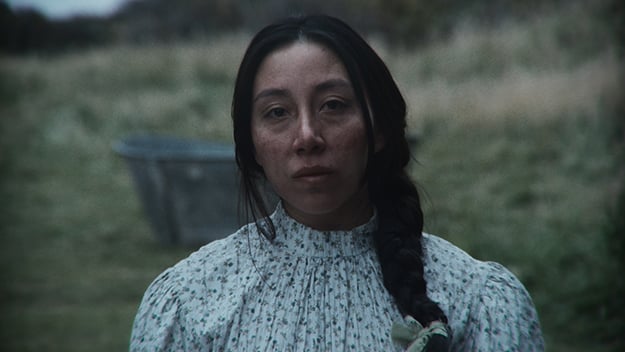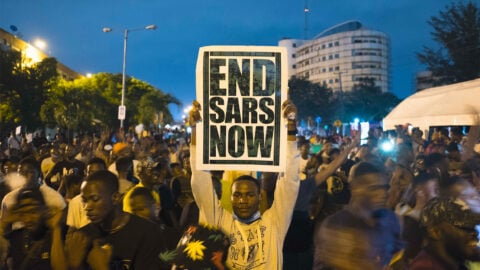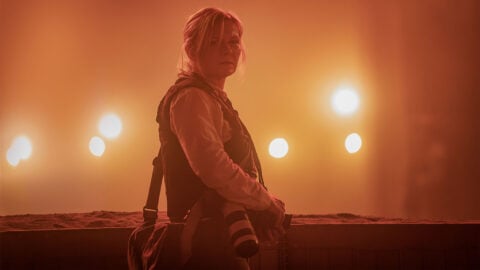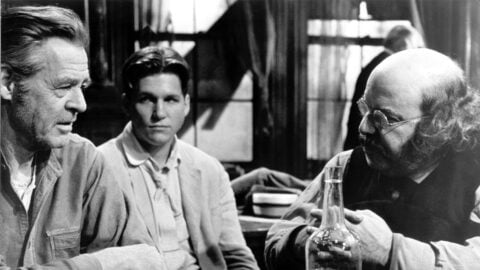Interview: Felipe Gálvez on The Settlers
This article appeared in the January 12, 2024 edition of The Film Comment Letter, our free weekly newsletter featuring original film criticism and writing. Sign up for the Letter here.

The Settlers (Felipe Gálvez, 2023)
The debut feature from Felipe Gálvez, The Settlers is a bracing retelling of a crucial moment in Chilean history, couched in the cinematic language of the nihilistic 1960s westerns of Sergio Leone and Monte Hellman. Though Gálvez looked at films like The Searchers (1956) for inspiration, there’s even a touch (to my eye) of the ur–acid western El topo (1970), by Gálvez’s countryman Alejandro Jodorowsky, in the glimmers of phantasmagoria that punctuate the hard-nosed realism of The Settlers.
The movie is composed of two overlapping sections, both inspired by real events. The first, set in 1901 in a remote stretch of Tierra del Fuego, tells the story of three outsiders—a Scottish soldier-turned-mercenary, a bloodthirsty American gunslinger, and a young mestizo forced into their service—who are tasked by a wealthy sheep farmer, José Menéndez, with ridding a vast stretch of the archipelago of its Indigenous inhabitants by any means necessary. As the trio make their bloody way from the prairies to the foothills of the Andes and out to the seashore, the film’s perspective becomes increasingly unmoored from the lead characters. Instead, a larger historical context starts to emerge: the viewer begins to see that these characters are just small players in a much bigger game, their murderous activities a cog in the machine of the ongoing political effort to build and define the nation of Chile. The third act is set a few years later, as a government agent named Vicuña arrives at the Menéndez homestead to “investigate” the genocidal crimes of the businessman’s employees. As we see in the film’s final scene, the government is, of course, less interested in justice than it is in controlling the narrative.
Last week I interviewed Gálvez, who is based in Paris, over video call. We discussed the blend of history and genre tropes in The Settlers, its striking score and graphic elements, and how Gálvez became interested in telling this story. The Settlers opens today, January 12, in theaters.
You have said that this is a story that has been erased from official histories of Chile. How long have you wanted to tell this story, and when did you formulate the idea of rendering it as a western?
I came across this idea about 15 years ago when I read in an independent newspaper accounts of the genocide of Indigenous people. What motivated me was a page from Chilean history that had been erased and distorted more than others, because that particular population [the Selk’nam, the Indigenous people of Tierra del Fuego] had been turned into images, souvenirs. If you go to the Santiago airport, you can find postcards with photos that are similar to the image in the movie of the man in the forest at night, in ceremonial dress. It could be a stuffed toy or a sticker for a skateboard company, but when that happens it’s important to recognize that it was a genocide and that person was murdered.
The other layer to this is that I love cinema, and so I began to think about how I could narrate this kind of drama from the point of view of those committing the crimes. The idea of making a western comes from thinking of John Ford and American classics. Through that, I came to the conclusion that the western was a tool of colonialism, an element of propaganda, and so I began to cross this story with the idea of the western as a genre of propaganda.
Well, The Birth of a Nation (1915) is one of the first great masterpieces of cinema, so there you have it.
There are two layers to this: my political motivation and my cinematic motivation. What I wanted to do was infiltrate the genre, occupy its rules, question it. This is a movie that is reflecting on the role of cinema within these processes.
I wanted to ask about the use of color, particularly the bright red text used for the titles and the chapter headings. There’s also a shift, over the course of the film, in the intensity and saturation of the colors of the characters’ clothes and the elements of the landscapes they move through.
When I first thought about the photography for the film, I imagined making the movie in black and white, because the only existing photographs of the Selk’nam are in black and white. Later I realized that using black and white was too much like capturing reality, and I wanted to approach this story through cinema, not reality. So then I thought about black-and-white pictures that had been painted and the first, static color photo experiments, the Autochromes, of the Lumière brothers. I wanted to situate this film in that artificial realm because cinema is a representation of reality but it’s also a distortion—that was very important for me. We used the colors of costumes to do that as well.
I wanted it to be clear that this movie is about real events, but it’s not a documentary. That’s what I tried to do with the red text: it’s a way to tell the audience that it’s a movie, it’s fiction, there’s going to be humor and irony and probably a lot of violence. It was also important for me that viewers understood that these are graphic elements. They’re not text as such.
How does the finished film incorporate the historical elements?
In the movie, there are characters that are real and others that are fictitious. José Menéndez really existed. The Menéndez family owned Tierra de Fuego and still own much of it today. Alexander MacLennan, “El Chancho Colorado,” also existed—he was Menéndez’s armed guard. There are now rivers and roads in Tierra de Fuego that bear his name, and there are statues dedicated to Menéndez. Also, Chile hired a judge, Vicuña—who appears in the film—at the turn of the century to investigate these crimes. But this judge slept at Menéndez’s house during the investigation.
At the same time, I wanted to investigate only one part of one story of the colonization of Tierra de Fuego, because it’s simply too big otherwise. My entry point is through the perspectives of the colonizers as they embark on their first mission. I don’t consider myself a researcher; I’m a storyteller, a filmmaker, and so I focus on the part of the story I want to tell, and that’s what I researched to construct this screenplay.
Where did the archival footage of colonial ceremonies and celebrations that we see in the end credits come from?
That is archival footage that simulates the movie that Vicuña, the government representative, is making [as part of his report on the genocide of the Selk’nam]. It’s composed of real images filmed in Chile, taken from the family archive of the Menéndez family, and from the funeral of the president. But I also manipulate these images, distort them, and change their meaning.
I started in cinema as an editor, and as an editor you learn how to conduct that kind of exercise. My movie is a western built from the cut-out scenes from other movies. The script consists of what I believe, based on my imagination, would have been erased from a script from another era.
I wanted to ask about the music—it’s so dramatic and Morricone-esque, and really helps “distort reality,” as you say.
The film always had a dual component: it could be a very contemplative movie, but it could also be a genre movie. I decided I wanted something in the middle, and what allowed me to do that was music. The composer, Harry Allouche, and I worked on the score for several months. We tried to look for a style for this film that would convey the message that this is a modular movie: it’s a western but it’s also an adventure film and a drama, and at moments it could be a horror film or political thriller.
After the scene in which the Indigenous people are massacred and the three horsemen come out, they are accompanied by very heroic music. It’s as if three rock stars were coming out, and that’s the way classic western heroes are introduced. That creates a contrast with the image, which allows me to create a dialogue with the spectator, and opens up a connection with other movies. Music allows me to do that.
What are you working on next?
I’d like to continue to make movies without heroes. I don’t think there are heroes, and I don’t want to continue to build these figures up. In order to do that I need to come up with another device to connect with the audience, and the classic devices are graphic components, cinematography, music, sound. That’s why this movie exaggerates the aesthetic component. People say it’s beautiful, but when you think about western movies, almost all western movies are beautiful and aesthetically incredible. They’re so beautiful that the terrible things they talk about don’t even seem all that terrible.







